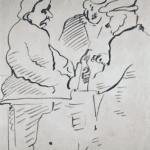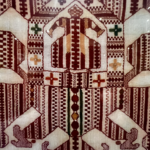Russian style was back in vogue, and Imperial porcelain soon followed suit. Commissioned by Nicholas I for the Grand Kremlin Palace in Moscow, the Kremlin Service made use of ancient Russian patterns. Other exciting historical styles surfaced during Nicholas’ reign. For the New Year of 1833, Nicholas was presented with the Gothic Service for the use in the Winter Palace. Inspired by the stained glass windows of medieval churches, the Gothic Service was used for the gala dinners of the Romanov family.
Also neo-Gothic in style, the Cottage Service was made for the Cottage – a small neo-Gothic palace near Peterhof, on the shores of the Gulf of Finland. Surrounded by meadows and forests, the Cottage was a romantic family home for the loving Imperial couple – the first Nicholas and Alexandra on the Russian throne. Nicholas’s wife Alexandra, born a Prussian princess, wrote with fondness about her husband, “With complete confidence and trust, I gave my life into the hands of my Nicholas, and he never once betrayed it.”
The Coronation Service of Nicholas I hearkened back to the previous neo-classical epoch. It featured the Imperial Eagle surrounded by the chain of St. Andrew against the Imperial ermine cloak, topped by the Imperial crown. During the coronation ceremonies of Nicholas I at the Kremlin, these plates were used at the Imperial table only while other guests used silver plates from the Kremlin Armory. After the coronation, the service was presumably never used again.












You must be logged in to post a comment.